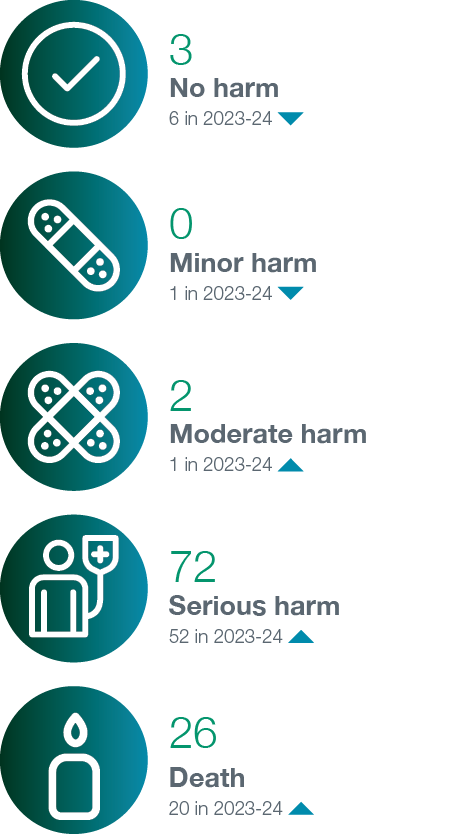The here and now
EMHS risk management and audit
The three lines of defence model employed by EMHS clearly defines functions that are involved and responsible for effective risk management.
These lines of defence are:
1. own and manage risks
2. oversee risks
3. provide independent assurance.
The EMHS Board Audit and Risk Sub-Committee forms part of the organisation’s wider governance framework and provides a key oversight role for the risk management and audit functions.
Some of the key activities performed by the Board Audit and Risk Sub-Committee for this period included:
- oversight of significant risks including treatment action plans (TAPs)
- oversight of the cybersecurity risk program of work
- approval of changes to the Internal Audit Plan, ensuring the function responded appropriately to immediate and emerging risks
- advocacy for the building of additional internal audit capacity.
Risk and compliance management
The risk management function has continued to provide first and second line defence across EMHS. Key achievements this year have been:
- the continued high level of compliance with the WA Health Risk Management Policy and EMHS Risk Policy, including a full year of risk review and TAP compliance above the 90 per cent performance target
- working with the EMHS Board and Executive to undertake a complete review of EMHS strategic risks and identification of new risks
- piloting of a new compliance obligation system to monitor key policy compliance requirements, fully aligned with the EMHS Enterprise Risk Management System.
Internal audit
In 2024-25, Internal Audit transitioned its function to align with the new Global Internal Audit Standards issued by the Institute of Internal Auditors. Conformance with the Standards will ensure EMHS Internal Audit Function remains relevant and effective in today’s complex environment, and that they are better equipped navigate evolving risks.
To assist EMHS with meeting its operational and strategic goals, the Internal Audit function provides the Board and Management with independent, risk-based, and objective assurance, advice, insight, and foresight.
The annual risk-based Internal Audit Plan assesses high risks and high-priority areas including patient identification, injury management and Aboriginal Languages Services, to identify opportunities for improvement to strengthen EMHS’ services to its patients.
In 2024-25, management was able to close 57 per cent of the internal and external recommendations logged for the year, while 43 per cent were in progress at the time of this report.
Continuing to deliver safe and high-quality care
Learning from clinical incidents
EMHS is very proud of the significant improvements we continue to make in improving the quality of health service provision and providing safe and high-quality care for our patients and consumers.
It is recognised however, that in such a complex and challenging environment, sometimes things can go wrong while accessing a hospital or health facility. EMHS is committed to finding out what happened, why it happened and how we can make changes to help prevent or reduce the risk of a similar incident occurring again.
During 2024-25, there were 193,155 patient admissions to EMHS hospitals. In addition, 217,945 patients were seen in our emergency departments and another 568,085 patients were seen in an outpatient clinic or setting.
As a testament to our professional and skilled workforce, the overwhelming majority of these interactions occurred without incident. However, for a very small percentage of patients, errors did regrettably occur during their care – and in some cases, these errors resulted in unintended harm.
In the interests of transparency, we are sharing the number of serious clinical incidents that occurred in 2024-25 at our hospitals and health services.
During 2024-25, there were 103 clinical incidents reported with a Severity Assessment Code (SAC) rating of 1 (SAC1). A SAC1 incident is a clinical incident that has, or could have, caused serious harm or death, and which is attributed to health care provision (or lack thereof) rather than the patient’s underlying condition or illness.
The number of SAC1 incidents is attributed to an increase in activity and a strong culture of reporting. The most reported types of incidents include patient accidents/falls, infection control and diagnostic processes/procedures. All SAC1 clinical incidents are subject to a rigorous investigation with the reports being reviewed by members of the EMHS Executive, as well as the EMHS Board Safety and Quality Committee; providing an opportunity for all EMHS hospitals to learn from incidents to improve the quality of care delivered across EMHS.
Morbidity and mortality (M&M) review is a forum for clinicians to openly and transparently discuss the quality of care provided to patients who have died or experienced significant morbidity while under the care of a health service. EMHS continues to identify opportunities for quality improvement and organisational learnings through the sharing of outcomes from M&M forums.
EMHS continues to actively participate in healthcare associated infection (HAIs) surveillance programs including the monitoring of hospital acquired blood stream infections (HABSI), enabling learning from current practice. EMHS continues to focus on providing the Vascular Access Service, which provides expert and specialist care in the insertion and management of invasive devices and provide clinicians with specialist vascular access training in the Emergency Department to enhance the skills of clinicians, particularly in handling patients with difficult intravenous access.
Of the 103 serious incidents reported in 2024-25, the patient outcome was noted as:


